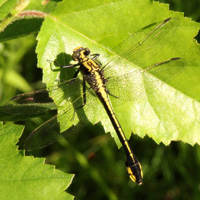Skillet Clubtail
Scientific name: Gomphurus ventricosus

Photo credit: Danny O’Shea
Status
Threatened
“Threatened” means the species lives in the wild in Ontario, is not endangered, but is likely to become endangered if steps are not taken to address factors threatening it.
Date added to the Species at Risk in Ontario List
January 29, 2024
Read the assessment report (PDF)
What it looks like
Skillet Clubtail is a small, slender dragonfly about 5 cm long.
It is dark brown and black with yellow markings along the top of abdomen, greenish-yellow markings on its thorax (the part of its body to which its legs and wings are joined), dark green eyes, and clear wings. It has a distinct flat, prominent circular expansion at the end of the abdomen that resembles a pan or skillet.
Where it lives
The range of Skillet Clubtail extends from New Brunswick, through southern Quebec and southern Ontario, west to Minnesota and south to Tennessee and North Carolina. Historical records indicate the species may have occurred in Nova Scotia as well.
Skillet Clubtails live up to 2 years as aquatic larvae. Larval habitat consists of slow-running rivers with a mix of silt, cobble, and bedrock. Most of the rivers where larvae live flow through a combination of forested and agricultural land. Larvae will burrow into fine silt or clay and when ready, drift downstream and emerge on the banks of pools or climb onto tree trunks.
Adults live approximately 2 months and carry out their lifecycle away from the river where they hatched, usually in forests and open habitats. Most adults return to the river to mate and do not migrate.
Where it’s been found in Ontario
Skillet Clubtail occurs in southern Ontario along the Saugeen River and has historically been found along the Ottawa River.
What threatens it
Four low impact threats to Skillet Clubtail have been identified in its Canadian range:
- habitat loss
- road and railroad-related mortality
- recreational activities such as boating resulting in wave-wash
- water pollution from agricultural and forest effluents
Action we are taking
This species and its habitat are protected under Ontario’s Endangered Species Act, 2007 (ESA).
The ESA also requires us to prepare recovery guidance for threatened species such as Skillet Clubtail.
All species listed on the Species at Risk in Ontario List may be eligible for consideration for government funding through the Species at Risk Stewardship Program.
What you can do
Report a sighting
Submit your observations of species at risk to the Natural Heritage Information Centre (NHIC), which is Ontario’s conservation data centre. Join the “(NHIC) Rare Species of Ontario” project in iNaturalist to make submitting your observations quick and easy.
Volunteer
Volunteer with species at risk programs, such as community science surveys, through your local nature club, a provincial park or other conservation organizations.
Be a good steward
- Private landowners have a very important role to play in species recovery. If you find species at risk on your land, you may be eligible for stewardship programs that support the protection and recovery of species at risk and their habitats. Learn more about the Species at Risk Stewardship Program.
- Invasive species seriously threaten many of Ontario’s species at risk. To learn what you can do to help reduce the threat of invasive species, visit:
- As with all wildlife, be respectful and observe from a distance.
Report illegal activity
Report any illegal activity related to species at risk to
Quick facts
- The name Skillet Clubtail refers to the slender abdomen of the adult dragonfly, having a broad, circular flare at the end that resembles a skillet.
- Most of a Skillet Clubtail’s life occurs underwater. Aquatic larvae have gills to breathe underwater and when they emerge, they begin to breathe air.
- The species is elusive, with only 1 confirmed sighting in 2012 and 1 historical sighting record from 1924 in Ontario.